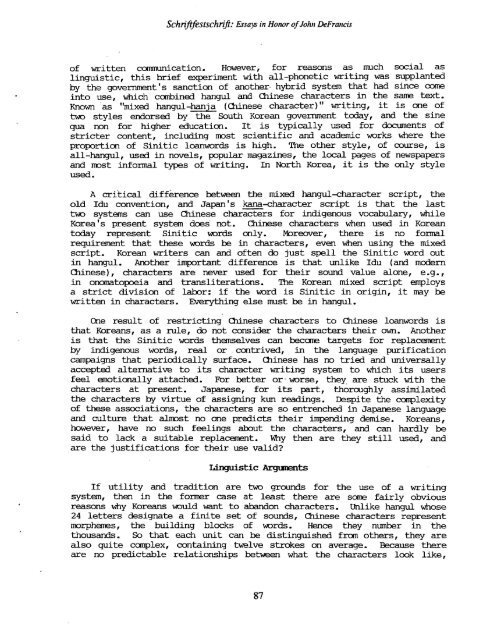Essays on Writing and Language in Honor - Sino-Platonic Papers
Essays on Writing and Language in Honor - Sino-Platonic Papers
Essays on Writing and Language in Honor - Sino-Platonic Papers
Create successful ePaper yourself
Turn your PDF publications into a flip-book with our unique Google optimized e-Paper software.
SchnJtJstschriifi: fisay <strong>in</strong> H<strong>on</strong>or of John &Francis<br />
of written cati<strong>on</strong>. However, for reas<strong>on</strong>s as much social as<br />
l<strong>in</strong>guistic, this brief experiment with all-ph<strong>on</strong>etic writ<strong>in</strong>g was supplanted<br />
by the government I s sancti<strong>on</strong> of another. hybrid system that had s<strong>in</strong>ce come<br />
<strong>in</strong>to use, which ccmb<strong>in</strong>ed hangul <strong>and</strong> Ch<strong>in</strong>ese characters <strong>in</strong> the same text.<br />
Known 'as "mixed hangul-hanja (Ch<strong>in</strong>ese character) " writ<strong>in</strong>g, it is <strong>on</strong>e of<br />
two styles endorsed by the South Korean government today, <strong>and</strong> the s<strong>in</strong>e<br />
qua n<strong>on</strong> for higher educati<strong>on</strong>. It is typically used for documents of<br />
stricter c<strong>on</strong>tent, <strong>in</strong>clud<strong>in</strong>g most scientific <strong>and</strong> academic works where the<br />
proporti<strong>on</strong> of S<strong>in</strong>itic loanwords is high. The other style, of course, is<br />
all-hangul, used <strong>in</strong> novels, popular magaz<strong>in</strong>es, the local pages of newspapers<br />
<strong>and</strong> most <strong>in</strong>formal types of writ<strong>in</strong>g. In North Korea, it is the <strong>on</strong>ly style<br />
used.<br />
A mitical difference between the mixed hangul-character script, the<br />
old Idu c<strong>on</strong>venti<strong>on</strong>, <strong>and</strong> Japan's kana--character script is that the last<br />
two systems can use Ch<strong>in</strong>ese characters for <strong>in</strong>digenous vocabulary, while<br />
Korea's present system does not. Ch<strong>in</strong>ese characters when used <strong>in</strong> Korean<br />
today represent S<strong>in</strong>itic words <strong>on</strong>ly, Moreover, there is no formal<br />
requirement that these words be <strong>in</strong> characters, even when us<strong>in</strong>g the mixed<br />
script, Korean writers can <strong>and</strong> often do just spell the S<strong>in</strong>itic mrd out<br />
<strong>in</strong> hangul, Amther important difference is that unlike Idu (<strong>and</strong> modem<br />
Ch<strong>in</strong>ese), characters are never used for their sound value al<strong>on</strong>e, e.g.,<br />
<strong>in</strong> <strong>on</strong>omatopoeia <strong>and</strong> transliterati<strong>on</strong>s. The Korean mixed script employs<br />
a strict divisi<strong>on</strong> of labor: if the word is S<strong>in</strong>itic <strong>in</strong> orig<strong>in</strong>, it may be<br />
written <strong>in</strong> characters. Everyth<strong>in</strong>g else must be <strong>in</strong> hangul,<br />
One result of restrict<strong>in</strong>g Ch<strong>in</strong>ese characters to Clh<strong>in</strong>ese loanwords is<br />
that Koreans, as a rule, do not c<strong>on</strong>sider the characters their own. Another<br />
is that the S<strong>in</strong>itic words themselves can becoane targets for replac-t<br />
by <strong>in</strong>digenous words, real or c<strong>on</strong>trived, <strong>in</strong> the language purificati<strong>on</strong><br />
campaigns that periodically surface, Ch<strong>in</strong>ese has no tried <strong>and</strong> universally<br />
accepted alternative to its character writ<strong>in</strong>g system to which its users<br />
feel emoti<strong>on</strong>ally attached. For better or - worse, they. are stuck with the<br />
characters at present. Japanese, for its part, thomghly assimilated<br />
the characters by virtue of assign<strong>in</strong>g kun read<strong>in</strong>gs. Despite the complexity<br />
of these associati<strong>on</strong>s, the characters are so entrenched <strong>in</strong> Japanese language<br />
<strong>and</strong> culture that -st no me predicts their impend<strong>in</strong>g demise. Koreans,<br />
however, have no such feel<strong>in</strong>gs about the characters, <strong>and</strong> can hardly be<br />
said to lack a suitable replacement. Why then are they still used, <strong>and</strong><br />
are the justificati<strong>on</strong>s for their use valid?<br />
If utility <strong>and</strong> traditi<strong>on</strong> are two grounds for the use of a writ<strong>in</strong>g<br />
system, then <strong>in</strong> the former case at least there are some fairly obvious<br />
reas<strong>on</strong>s why Koreans would want to ab<strong>and</strong><strong>on</strong> characters, Unlike hangul whose<br />
24 letters designate a f<strong>in</strong>ite set of sounds, mese characters represent<br />
morphemes, the build<strong>in</strong>g blocks of words, Hence they number <strong>in</strong> the<br />
thous<strong>and</strong>s, So that each unit can be dist<strong>in</strong>guished from others, they are<br />
also quite complex, c<strong>on</strong>ta<strong>in</strong><strong>in</strong>g twelve strokes <strong>on</strong> average. Because there<br />
are no predictable relati<strong>on</strong>ships between what the characters look like,

















